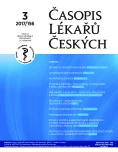Disorders of water and electrolyte metabolism and changes in acid-base balance in patients with ascitic liver cirrhosis
Authors:
Halima Gottfriedová 1; Miroslava Horáčková 2; Milena Čáslavská 3; Julius Špičák 4; Otto Schück 5
Authors‘ workplace:
Klinika hepatogastroenterologie TC IKEM
1; Interní klinika 2. LF UK a FN Motol
2; Klinika nefrologie TC IKEM
3; Klinika hepatogastroenterologie TC IKEM
4; Interní klinika 2. LF UK a FN Motol
5
Published in:
Čas. Lék. čes. 2017; 156: 150-152
Category:
Review Article
Overview
In patients with advanced cirrhosis with ascites disorders of water and electrolyte metabolism are often present and they are associated with changes in acid-base balance. These changes can be very complicated, their diagnosis and treatment difficult. Dilutional hyponatremia is the most common disorder. Hyponatremia in these patients is associated with increased morbidity and mortality before and after liver transplantation. Other common disorders include hyperchloremic acidosis, hypokalemia, metabolic alkalosis, lactic acidosis, respiratory alkalosis. If renal impairment occurs (for example hepatorenal syndrome), metabolic acidosis and retention of acid metabolites may develop.
The pathogenesis of these conditions applies primarily hemodynamic changes. Activation of renin-angiotensin-aldosterone system and non-osmotic stimulation of antidiuretic hormone trigger serious changes in water and natrium-chloride metabolism. This activation is clinically expressed like oedema, ascites, hydrothorax, low to zero natrium concentration in urine and increased urinary osmolality, which is higher than serum osmolality. In practice, the evaluation can be significantly modified by the ongoing diuretic therapy. Closer monitoring of water and electrolyte metabolism together with acid-base balance in patients with ascitic liver cirrhosis is important, not only in terms of diagnosis but especially in terms of therapy.
Keywords:
ascitic liver cirrhosis, dilutional hyponatremia, retention of solute-free water, acid-base balance, diuretic therapy
Sources
1. Ginès P, Cárdenas A. The management of ascites and hyponatremia in cirrhosis. Semin Liv Dis 2008; 28: 43–58.
2. Restuccia T, Gómez-Ansón B, Guevara M et al. Effects of dilutional hyponatremia on brain organic osmolytes and water content in patients with cirrhosis. Hepatology 2004; 39: 1613–1622.
3. Funk GC, Doberer D, Osterreicher C et al. Equilibrium of acidifying and alkalinizing metabolic acid-base disorders in liver cirrhosis. Liver Int 2005; 25: 505–512.
4. Oster JR, Perez GO. Acid-base disturbances in liver disesase. J Hepatol 1986; 2: 299–306.
5. John S, Thuluvath PJ. Hyponatremia in cirrhosis: pathophysiology and management. World J Gastroenterol 2015; 21: 3197–3205.
6. Ahya SN, José Soler M, Levitsky J, Batlle D. Acid-base and potassium disorders in liver disease. Semin Nephrol 2006; 26: 466–470.
7. Nagaoka D, Nessar Junior AP, Maciel AT et al. The use of sodium-chloride difference and chloride-sodium ratio as strong ion difference surrogates in the evaluation of metabolic acidosis in critically ill patients. J Crit Care 2010; 25: 525–531.
8. Kurt A, Ecevit A, Ozkiraz S et al. The use of chloride-sodium ratio in the evaluation of metabolic acidosis in critically ill neonates. Eur J Pediatr 2012; 171: 963–969.
9. Schück O, Horáčková M. Diference a poměr sérových koncentrací natria a chloridů u pacientů s hyponatremií. Vnitřní lékařství 2016; 62: 629–634.
10. Schück O, Hoenig V, Šmahelová R. Liver cirrhosis and the elaboration of hypertonic urine. Rev Czech Med 1960; 6: 112–117.
11. Jabor A. Vnitřní prostředí. Grada Publishing, Praha, 2008.
12. Stanley NN, Salisbury BG, McHenry LC Jr, Cherniack NS. Effect of liver failure on the response on ventilation and cerebral circulation to carbon dioxide in man and in the goat. Clin Sci Mol Med 1975; 49: 157–169.
13. Greger R, Heidland A. Action and clinical use of diuretics. In Davison AM et al. Oxford Textbook of Clinical Nephrology, 2nd ed. Oxford University Press: Oxford, New York, Tokyo, 1998: 2679–2706.
14. Rosner MH. Severe hyponatremia associated with the combined use of thiazide diuretics and selective serotonin reuptake inhibitors. Am J Med Sci 2004; 327: 109–111.
Labels
Addictology Allergology and clinical immunology Angiology Audiology Clinical biochemistry Dermatology & STDs Paediatric gastroenterology Paediatric surgery Paediatric cardiology Paediatric neurology Paediatric ENT Paediatric psychiatry Paediatric rheumatology Diabetology Pharmacy Vascular surgery Pain management Dental HygienistArticle was published in
Journal of Czech Physicians

- Metamizole at a Glance and in Practice – Effective Non-Opioid Analgesic for All Ages
- Metamizole vs. Tramadol in Postoperative Analgesia
- Advances in the Treatment of Myasthenia Gravis on the Horizon
- Spasmolytic Effect of Metamizole
- What Effect Can Be Expected from Limosilactobacillus reuteri in Mucositis and Peri-Implantitis?
Most read in this issue
- Basal cell carcinoma and the modalities of its therapy
- Diseases affecting the scalp
- Hirsutism – etiopathogenesis, diagnostics and treatment
- Androgenetic alopecia in women
